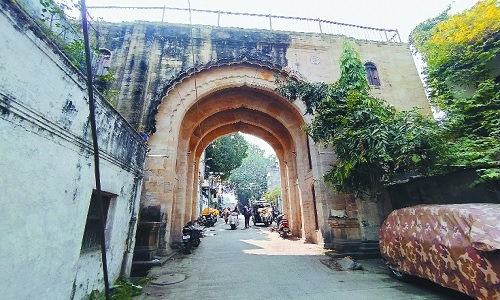History’s flip-flop of time-line
| Date :19-Jan-2023 |

By Maitrayee Sangitrao
HISTORY is a moment recognised in past, a moment of achievement, destruction, art, culture, the human story. It’s a pendulum clocking in and out on eras, regimes -- sometimes overlapping and mingling. The succeeding generations then struggle to decipher time’s metaphor through events and dates whose chronology is possibly confusing.
The city of Nagpur, ruled by two distinct dynasties -- the Gonds and the Bhonslas -- for more than two centuries on the trot, is one such story that offers a challenge to researchers in terms of decision on time-line of certain events and landmarks in the city. Of course, there could be many such stories, but the one that attracts attention is the estate of the old Royal Gond Palace hidden and tucked away in the vicinity of Mahal.
Much of the estate is in ruins, but the gate still stands tall and strong, communicating a sense of hurt pride. It’s grandeur cannot be missed. The Gond King Palace Gate, also known as Nagarkhana, is history arrested in stone amidst the sprawling congested locality of urban rush. Its imposing edifice once attracted everybody’s attention from far. The structure speaks of it’s time and era, giving a glimpse of the old fortified city of Nagpur.
Today, however, the gate has acquired an apologetic, compromised identity -- thanks to the stupid, senseless and unplanned urban congestion. True, the authorities slept and the people heaped an unplanned insult on the city’s history.
Obviously, the gate appears to be refurbished on a few occasions, which is clearly visible from the construction. A plaque, in Urdu and Farsi (and translated into English, appears on a metal plate in Nagpur’s Central Museum) tells that the gate was constructed in 1874. This year creates confusion, resolution of which does not appear simple. Because, if the Bhonsla dynasty ruled Nagpur after the Gond dynasty, then how can this particular gate to the Royal Gond Palace be constructed as late as 1874 when the Bhonsla regime had ended?
Or, by another interpretation, Gond royal family still lived in the city and built the gate to its estate, probably rebuilt to undo disrepair. But, there appears to be only scant records to suggest any of these. The Central Museum sports a picture of the old gate to the Royal Gond Palace which does not actually and precisely match the present structure. Who knows, the gate might have gone through multiple repairs and refurbishments (whose details might not have been recorded). In that case, probably, the year ‘1874’ relates to the last repair.
‘The Hitavada’ tried to get a clearer idea of this flip-flop of time-line, but could not find an authentic answer to many questions. Attempts to obtain clarifications from museum authorities drew no response. History has played its part with many such structures symbolising its details.
The real question, however, is about the future of such structures. The current condition of the heritage structure is alarming. A visit brings to fore a grim picture of the place with garbage and liquor bottles strewn in the rooms. The question here is: Does the society give such places a proper thought and bring them into use by repurposing them as historical attraction sites, or commercially exploitable structures? Can such structures be woven into larger themes of tourist attractions by designing around them some entertainment areas that would draw footfalls? Of course, such repurposing need not disturb the original aethetics.
Speaking to ‘The Hitavada’, history researcher Atharva Shivankar said, “Repurposing historical building is the need of the hour. Best examples are Wada or mansions being used as hotels. Similar ideas need to be executed, especially in places that do not have any religious importance like doorways and cenotaphs. These places have the potential of reappearing as convention centres and venues for occasions celebrating the history of the city.”
Expanding on the idea, urban planner Mukul Kogje said, “One reason why such places are ignored is accessibility. Repurposing these places for recreational activities for the local public will help instill a sense of responsibility and belongingness.”
Amidst the vicinity of the palace is another structure -- the Bastion, an example of the anthropogenic impact of the environment and utter human neglect. “The Bastion is the only remaining evidence of the old walled city of Nagpur. Neglect of these structures is a cause of serious concern. If the correct measures are not taken, the Bastion will fall and one of the city’s structures will be lost,” said conservation architect Sandeep Pathe. The Bastion is now fully covered in vegetation, posing a threat to its structural stability.
Shedding some light on the issue, Avanti Tohare, Assistant Town Planner, Town Planning and Valuation Department, Maharashtra Government, observed that it was the responsibility of the local body and the Heritage Committee to take immediate action. “Preservation of the city’s history could help us tap into Nagpur’s tourism potential,” she added.
The Gond King Palace Gate represents a period of Nagpur’s history, half of which is lost to time. Measures must be taken to protect it from human intervention that may pose a threat to the structure. The place, despite its current condition, tells in unspoken words the history that can only be sensed in the head and the heart. It is necessary to protect the history to protect the sense of connection to the past.